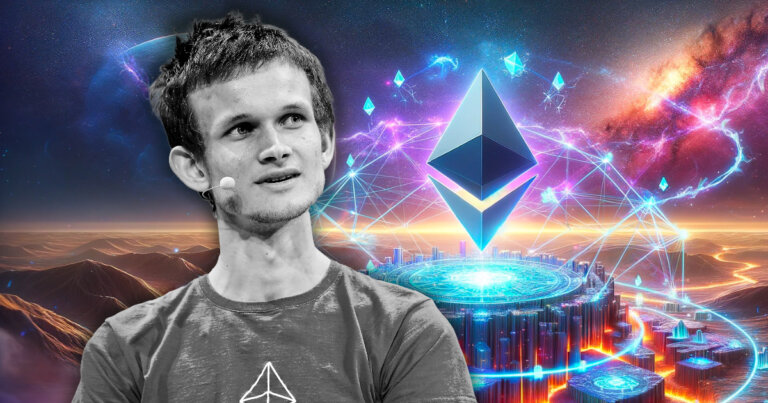 Vitalik Buterin signals potential Plasma scaling resurgence with tech enhancements
Vitalik Buterin signals potential Plasma scaling resurgence with tech enhancements Vitalik Buterin signals potential Plasma scaling resurgence with tech enhancements
Vitalik Buterin rekindles interest in Plasma scaling solutions with an eye on ZK-SNARK improvements for enhanced security and efficiency.

Cover art/illustration via CryptoSlate. Image includes combined content which may include AI-generated content.
In a recent blog post, Ethereum co-founder Vitalik Buterin revisited the concept of Plasma, a once-prominent scaling solution, underscoring its potential resurgence in the blockchain ecosystem with new technological advancements.
As Vitalik Buterin explains, Plasma, a blockchain scaling framework first introduced in 2017, is poised for a comeback. Initially overshadowed by rollup technology due to its inherent limitations in client-side data storage and adaptability beyond simple payments, Plasma is garnering renewed attention. Buterin’s perspective, shaped by advancements in validity proofs, particularly ZK-SNARKs, highlights how these developments could mitigate Plasma’s previous shortcomings.
Editor’s Note: For those who struggle with Vitalik’s complex blog posts, we’ve added a simplified explanation below.
The Mechanics of Plasma Reimagined
Buterin’s post delves deep into the workings of Plasma, specifically Plasma Cash. This iteration treats each coin as an NFT, creating a separate history and employing a sparse Merkle tree for transaction storage. The Plasma chain operator’s role is crucial here, responsible for block production and ensuring data availability. Buterin underscores the importance of this mechanism, which is fundamental to the scalability and security of the Plasma framework.
Users must vigilantly monitor for operator misconduct, a process managed through ‘exit games.’ These games allow users to exit their holdings within a specified period in case of anomalies, a critical safety measure in Plasma’s design. Buterin’s explanation of this process reflects his vision of a user-empowered, secure blockchain environment.
Buterin does not shy away from addressing the challenges of extending Plasma to the Ethereum Virtual Machine (EVM). He acknowledges the difficulty in adapting Plasma for applications beyond payments, primarily due to the EVM’s complex state objects and unbounded dependencies. This candid assessment from Buterin illustrates the hurdles in achieving a more versatile Plasma framework.
Validity proofs, especially ZK-SNARKs, are central to Buterin’s renewed advocacy for Plasma. According to Buterin, these tools can substantially simplify the Plasma design, reducing the data burden on users and enhancing security. This advancement aligns with Buterin’s long-standing vision of a more efficient, secure blockchain infrastructure.
EVM Compatibility: A New Approach with UTXO Graphs
Buterin proposes using validity proofs to create parallel UTXO graphs for ETH and ERC20 tokens. This approach would facilitate a smoother interaction with the EVM, potentially overcoming previous limitations. His post reflects an innovative mindset, seeking solutions that harmonize complex technologies.
Despite his optimism, Buterin remains pragmatic about Plasma’s limitations in the EVM context, especially concerning state objects lacking a clear economic owner. He uses examples like CDPs and privacy systems to illustrate these challenges, emphasizing the need for specialized solutions.
Plasma’s Place in the Blockchain Future
Buterin acknowledges that while rollups remain the dominant scaling solution, Plasma, with its new enhancements, could play a significant role in the evolving blockchain landscape. His insights underscore Plasma’s potential in reducing transaction fees and enhancing chain security, advocating for its strategic implementation alongside existing technologies.
Vitalik Buterin’s post profoundly reflects Plasma’s potential in the current blockchain ecosystem. His insights provide a glimpse into blockchain technology’s ongoing efforts to balance scalability, security, and efficiency.
What is Plasma, Anyway?
Editor’s Note: For those of us who struggle in the complex world that Vitalik’s brain lives in, here is an overview for the rest of us.
Think of Plasma as a unique tool designed to make blockchain transactions faster and more efficient. Initially, it was like a sidekick to the main Ethereum blockchain, handling transactions separately to reduce clutter and speed things up. However, it had some issues and was overshadowed by newer technologies.
Why is Plasma Back in the Spotlight?
Vitalik suggests giving Plasma another chance because of new tech improvements, especially something called ZK-SNARKs (a way to prove data is true without revealing the data itself). These improvements could fix the old problems Plasma had, making it useful again for handling lots of transactions quickly.
How Does Plasma Work Now?
Plasma works by treating each transaction or coin like a unique item (like an NFT). There’s a person (or group) in charge of the Plasma system who regularly updates and organizes these transactions. If they mess up or act shady, users have a way to pull out their assets safely.
What About More Complex Transactions?
Vitalik acknowledges that using Plasma for more than simple transactions, like trades or payments, is challenging. The current form of Plasma isn’t great at handling complex operations on Ethereum, like those run by smart contracts.
How Can Plasma Improve?
Using those ZK-SNARKs, Plasma can potentially handle transactions more securely and require less user data. This means faster and safer transactions. Vitalik also talks about tweaking how Plasma interacts with Ethereum to make it more versatile.
Vitalik’s Takeaway
Vitalik thinks that while the current popular method (rollups) is good for scaling, Plasma could be a valuable addition. It could help reduce fees and make transactions more secure. He believes it’s worth exploring how Plasma can fit into the future of blockchain.
In summary, Vitalik proposes revamping Plasma using new tech to handle loads of transactions more quickly and securely. It’s like giving an old car a new engine to make it run smoother and faster but acknowledging there’s still some way to go before it can compete with the latest models.




 Arkham Intelligence
Arkham Intelligence 

 Farside Investors
Farside Investors 
 CryptoQuant
CryptoQuant 
 CoinGlass
CoinGlass 













































































































